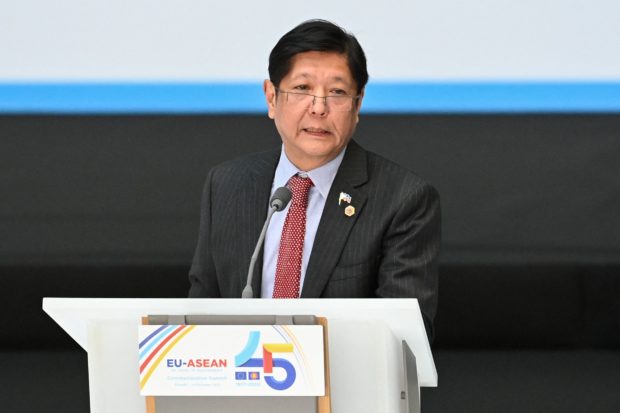Bongbong Marcos: Gov’t gradually transitioning to surface water from groundwater

President Ferdinand “Bongbong” Marcos Jr. | FILE PHOTO: John THYS / AFP
MANILA, Philippines — President Ferdinand “Bongbong” Marcos Jr. on Monday said the government is slowly converting the country’s dependence on water supply from underground water to surface water.
This, he said, is one of the government’s efforts in preparing to address the looming El Niño phenomenon.
“Kasi tubig ang pinag-uusapan, marami talagang elemento na kailangan isama diyan sa usapan na ‘yan. But we are slowly converting our dependence on water supply from underground water to surface water. ‘Yun ang pinaka-basic diyan and then the distribution systems,” Marcos said in a radio interview.
(We’re talking about water, which has many elements that must be discussed. But we are slowly converting our dependence on water supply from underground water to surface water. That’s the very basic we’re doing and the distribution systems.)
“Kung pupuntahan mo ‘yung mga distribution system natin sa mga water authority, kung titingnan mo ‘yung mga ano, noong panahon pa ng giyera eh noong nilagay ‘yung mga tubo-tubo eh,” he added.
Article continues after this advertisement(If we go to our distribution system in water authorities, we can see that the pipes have been there since the war.)
Article continues after this advertisementMarcos earlier said he had signed an executive order that would create the Office of Water Management, which aims to manage the country’s water resources and respond to present environmental challenges.
Malacañang, however, has yet to release a copy of the order.
The President said the government platform would help deal with the country’s water crisis.
“Kailangan na magkaroon ng sapat na supply ng malinis, ligtas na tubig na kahit pag masyadong mahina ang ulan o nagka-El Niño, masyadong mainit ay magkakaroon tayo ng… mayroon pa rin tayong water supply,” he explained.
(We need enough clean and safe water so that even though we experience El Niño, we would still have supply.)
“Ngayon, kung talagang hanggang ngayon ay wala pa, kulang pa, ang gagawin natin siyempre pag-aaralan natin kung saan talaga ang priority. Saan ang uunahin? ‘Yung mga city ba, ‘yung mga agrikultura ba? Bawat lugar ay iba. Iba siyempre, ‘yung mga urban communities, ‘yung mga siyudad. ‘Yung freshwater, ‘yung drinking water,” he added.
(If our supply is still lacking, we will study where we can prioritize. Do we prioritize cities or agricultural areas? Each area is different from one another.)
The President said the government had ramped up its alert and warning systems to provide El Niño forecasts and impacts.
“Kaya’t, ‘yun isa pa ‘yan, pinapatibay natin ang kakayahan ng DOST (Department of Science and Technology), ng Pagasa (Philippine Atmospheric, Geophysical and Astronomical Services Administration) para ma-warning-an naman talaga tayo nang mabuti na may parating na ganito,” Marcos said.
(That’s why we strengthened the DOST and Pagasa so that we can be warned if an El Niño phenomenon occurs.)
In a previous sectoral briefing, Marcos directed agencies to develop a whole-of-government strategy to address the El Niño phenomenon that may hit the country this year until early next year.
Two specific instructions given by the President are adopting a whole-of-government or whole-of-nation approach and putting up protocol-based and scientific long-term processes that could be adopted by the country.